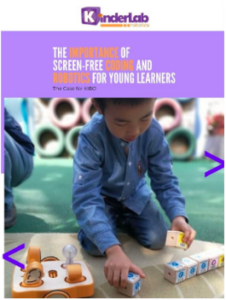THE Journal: 4 Hands-On STEAM Projects that Also Teach Other Skills
In Jason Innes’ newest article, he shares 4 fun, engaging and rich STEAM projects that help educators and learners make the most of being in the same physical space together — and also reinforce concepts like social-emotional learning, literacy, and the engineering design process…whether or not you have a KIBO robot!
The 4 STEAM projects include:
SEL Through Superhero Robots
To help students think about ways to care for each other, their school, and their community, ask them to design and program Superhero Robots. Depending on what sort of robots you have in your classroom, students can brainstorm ways their robots might use their super-speed wheels, super-hearing sound sensors, or super-bright lights to help and protect the community. They can then create superhero costumes with arts and crafts materials, and finally, program their helper robots to move around the classroom and exhibit their superpowers.
Literacy Through Reader’s Theater
Coding and robotics give children a new literacy that they can use for self-expression. Teachers can reinforce this literacy connection through a “Reader’s Theater” activity where the decorated robot becomes a character from a student’s favorite story, and the program captures the movements and actions of the plot. Storybooks featuring a journey, such as Maurice Sendak’s Where the Wild Things Are or Michael Rosen and Helen Oxenbury’s We’re Going on a Bear Hunt, work particularly well for this activity. Children can read aloud to narrate the story as the robot moves through the environments re-enacting the plot.
The Engineering Design Process Through Floating Boats
Teachers kick off this activity by presenting small groups of students with a range of craft and recycled materials, such as boxes, cans, popsicle sticks, string, and tape. The goal is to use a limited set of materials to build a sturdy boat capable of supporting weight without sinking. Coins or stones work well as weights that can be added gradually to create drama and a sense of friendly competition among the groups.
Sequencing and Representation Through the ‘Programmer Says’ Game
Being together in the classroom also means learning playfully together through movement and music games. Following the principles of kinesthetic learning, teachers can create games where students use their own movements to make sense of sequencing and representation, two key concepts in coding and computational thinking. Similar to “Simon Says,” “Programmer Says” is a game where the teacher presents students with a sequence of programming commands to act out in the correct sequence, either with or without an actual robot.
Read the full article.



















